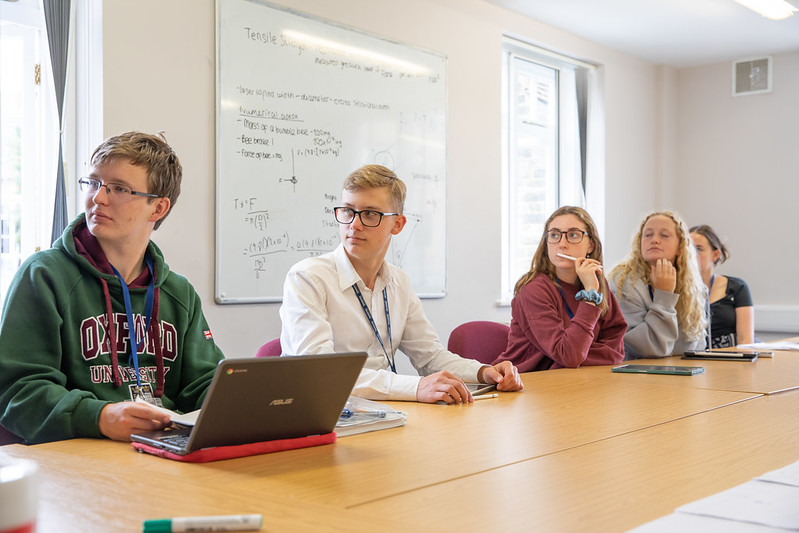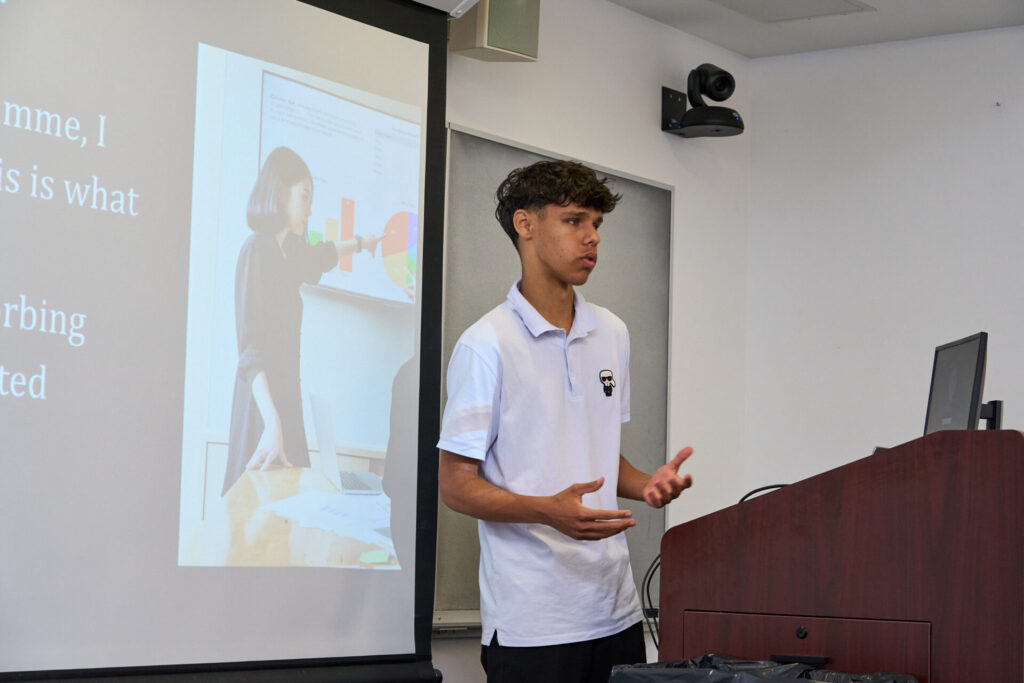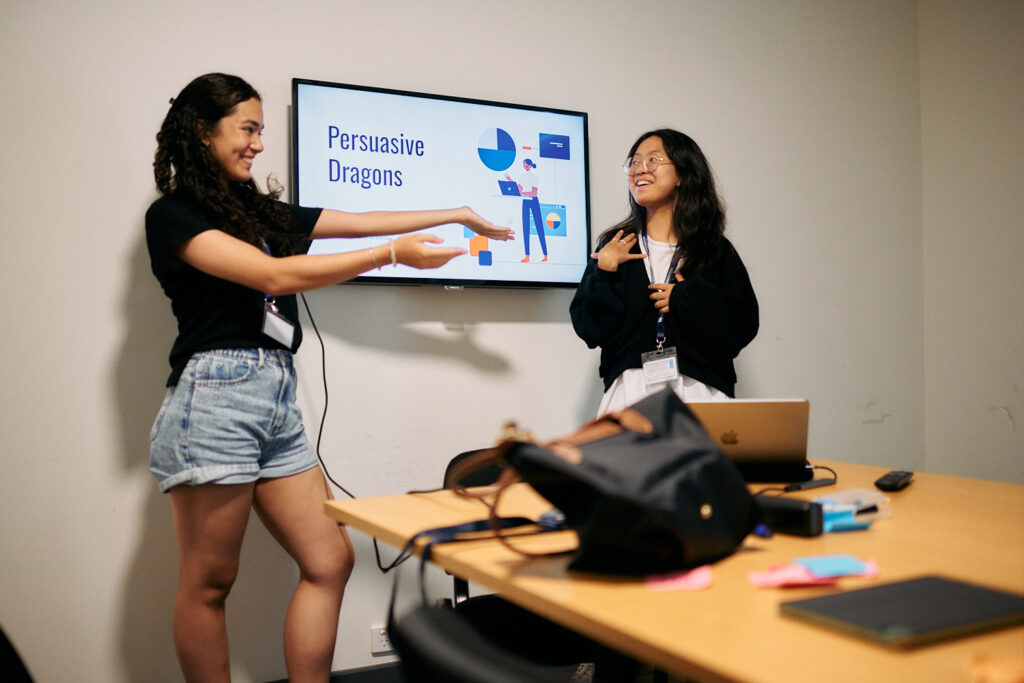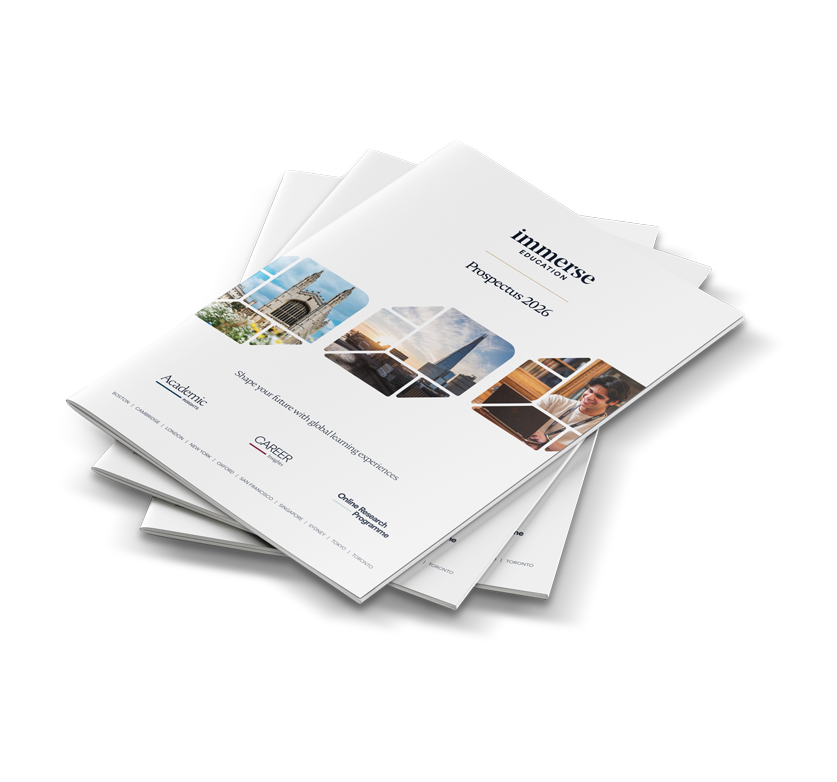Public speaking is like learning to play an instrument. At first, every note feels uncertain, but with practice and guidance, the melody begins to flow. Mastering our public speaking tips for students will help you turn those first shaky moments into confident expression.
Each talk becomes a performance shaped by rhythm, timing, and emotion.
You’ll discover how to plan, practise, and speak with purpose so your message truly connects.
Inspired by our TED Summer School, we’ll explore how you can transform fear into fluency and confidence into impact. The tips in this article will cover everything from planning to delivery, as well as specialist advice on online/virtual delivery.
What Makes TED Speakers So Effective
TED speakers captivate audiences through storytelling, structure, and emotion. Their talks stand out because they combine clarity with connection, turning complex ideas into moments that inspire reflection and action.
Every great talk begins with purpose and ends with impact, and you can achieve the same.
You can follow their example by focusing on three essentials:
- Clear, focused messaging that communicates one powerful idea.
- Body language that shows confidence through posture, eye contact, and movement.
- Relatable stories or data-driven examples that make your ideas memorable and meaningful.
12 Public Speaking Tips For Students
Great public speakers aren’t born confident. They build skill through practice and reflection. Whether you’re preparing for a debate, presentation, or TED-style talk, these tips will help you plan, deliver, and speak with clarity and purpose.
1. Plan Your Talk and Know Your Main Message
Every great speech begins with focus. Chris Anderson, Head of TED, says, “Your number-one mission as a speaker is to take something that matters deeply to you and rebuild it inside the minds of your listeners.”
Before you begin writing, ask yourself what you want people to remember most. That single idea becomes the foundation of your talk. When you plan around it, every story, fact, and example connects with purpose and direction.
This clarity helps your audience follow your message and remember it long after you finish speaking.
2. Think About Who You’re Talking To
Every audience is different, so knowing who you’re speaking to shapes how you prepare and deliver your message. The language that excites a group of young students might not work with business professionals, and a speech for classmates will sound different from one for judges or teachers.
Ask yourself what your audience values and how familiar they are with your topic. This helps you choose examples, tone, and stories that feel relevant and respectful.
The best TED speakers do this instinctively. They adjust their delivery, simplify complex ideas, and make every listener feel included. When you tailor your talk in the same way, you build trust and genuine connection.
3. Tell a Story That Connects
Stories make people listen. They turn facts into feelings and ideas into something we can remember. Whether it’s a moment of failure, discovery, or change, a personal story helps your audience see the person behind the message.
TED speakers like Chimamanda Ngozi Adichie use stories to make global ideas feel personal. You can do the same by sharing experiences that show what you’ve learned or why your message matters.
At our TED Summer School, participants explore how storytelling transforms communication. By linking emotion with structure, you’ll learn how to turn any talk into a story that inspires and stays with your audience.
Whether you’re in Singapore, London or New York, the TED summer school’s learning environment values discussion, collaboration, and analytical thinking, helping you articulate ideas with clarity and confidence. Through seminars, presentations, and real-time feedback, you’ll learn to present arguments persuasively and engage audiences thoughtfully.
4. Start Small and Build Confidence
You don’t start by climbing Mount Everest. You begin with smaller hills that prepare you for the summit ahead. Public speaking works the same way, and confidence grows one step at a time.
Start by speaking in familiar situations such as answering a question in class, joining a discussion, or delivering a short presentation to your friends. Each small experience builds strength and self-assurance. Remember: a talk doesn’t need to be on a serious topic! Why not make a power point about your favourite band’s last album, or what you’ve been up to over summer, and present to a willing audience in the name of practise?
The more you practise, the easier it becomes to manage nerves and speak naturally. Every small success prepares you for bigger stages and helps you find your own confident voice. This gradual approach is one of the most practical public speaking tips for students, helping you build genuine confidence over time.
5. Give Your Talk a Clear Beginning, Middle, and End
Every memorable talk follows a simple structure that guides the audience from curiosity to understanding. A clear beginning captures attention, the middle develops your main idea, and the end leaves a lasting impression.
Think of your talk as a journey. The introduction sets the direction, the body explores the path, and the conclusion brings your listener safely to the destination. When your speech has this flow, people stay engaged and remember your message.
Practise outlining your key points before you start writing. Structure gives your ideas shape and helps your audience follow your message with ease.
6. Open with Something That Grabs Attention
The first few seconds of your talk decide whether people will listen. A strong opening draws your audience in and sets the tone for everything that follows. The best speakers use different types of hooks to make people care right from the start.
Here are a few effective ways to begin:
- Statistic: Start with a surprising fact that makes your audience think differently about your topic.
- Question: Ask something that invites curiosity or reflection.
- Quote: Use an inspiring or thought-provoking line from someone respected.
- Metaphor or Analogy: Create a vivid image that links your idea to something familiar.
- Scene or Anecdote: Describe a relatable moment to make your audience feel part of the story.
- Contrast or Surprise: Challenge a common belief to grab attention instantly.
Choose a hook that fits your topic and tone. A strong opening does more than capture attention; it builds anticipation for the message that follows. Mastering these openings is one of the most effective public speaking tips for students, ensuring your audience stays engaged from the very first moment.
7. Use Your Voice and Body to Show Confidence
In her TED Talk “Your Body Language Shapes Who You Are,” Amy Cuddy explains that posture can change not only how others see you but also how you see yourself. The way you stand, move, and speak sends powerful signals of confidence and credibility.
Stand tall with open shoulders and steady eye contact. These small adjustments show assurance even when you feel nervous. Vary your tone, slow your pace, and use pauses to emphasise key points.
Your voice and body work together to express conviction. When you practise confident delivery, it starts to feel natural and your message carries greater impact.
8. Speak Clearly and Use Simple Words
You’ve been practising for days, and now it’s your turn to speak. You begin confidently, but halfway through, you notice your classmates looking confused. You realise your words sound more complicated than you meant them to.
The most effective speakers use simple, direct language that everyone can follow. Avoid long sentences or technical terms that might lose your audience. Choose short, clear phrases that express your ideas with confidence and precision.
Clarity builds connection. When people understand you easily, they listen more closely and remember your message. Speaking simply makes your ideas stronger and your voice more powerful.
9. Stay Calm and Breathe Before You Begin
Most people think great speakers never get nervous, but even TED speakers do. Marina Abramović, a performance artist known for her fearless work, once admitted, “I was so nervous!” before giving her TED Talk. If someone who performs in front of millions can feel anxious, it’s completely normal that you might too.
The key is learning how to manage it. Taking a few slow, steady breaths before you begin helps calm your body and focus your thoughts. Breathing deeply lowers your heart rate, steadies your voice, and gives you a moment to collect yourself.
When you pause to breathe, you reset your focus and remind yourself that confidence isn’t the absence of nerves; it’s the ability to keep speaking with composure despite them.
10. Practise with Friends or Family for Feedback
Confidence grows through repetition and reflection. Rehearsing your talk in front of people you trust helps you see how others perceive your message and delivery.
Ask your friends or family to share what stood out, what confused them, and how you could improve. Their feedback helps you notice habits you might miss, such as speaking too quickly or avoiding eye contact.
TED speaker Julian Treasure, in his talk “How to Speak So That People Want to Listen,” reminds us that the voice is an instrument. Use practice sessions to fine-tune your tone, volume, and pace until your message sounds natural and clear.
Each rehearsal brings you closer to confidence. The more you practise speaking aloud, the more authentic and effortless your delivery becomes.
11. Try Helpful Tech Tools to Improve
Technology can be one of your best teachers. Recording yourself on your phone or laptop helps you notice how you sound and what your audience might see. Watching your playback may feel uncomfortable at first, but it’s one of the quickest ways to improve.
You can also use practical tools such as Orai for real-time feedback on tone and pacing, Ummo to track filler words, or PromptSmart for smooth digital cueing. Even simple voice recorder or video apps can help you analyse gestures, timing, and expression.
Practising with these tools gives you a clearer sense of how you sound to others and helps you refine your confidence through consistent improvement.
12. End Strong and Reflect on What You Learned
The way you finish your talk is what your audience will remember most. A strong ending leaves them inspired, thoughtful, or ready to take action. Summarise your key message, share what the experience taught you, or end with a short story that brings your idea full circle.
Reflection is just as important as delivery. After your talk, ask yourself what went well and what you could improve next time. Each presentation helps you grow more confident and self-aware as a speaker.
As TED speakers often show, powerful endings aren’t just about applause; they are about leaving your audience with something to think about long after you’ve finished speaking.
Speaking in the Digital Age: Online & Hybrid Presentation Tips
Public speaking isn’t limited to the stage anymore. In today’s world, public speaking tips for students also apply to online communication, where clarity, confidence, and presence matter just as much as in person. Whether you’re joining a virtual class or presenting online, these simple tips will help you sound and look professional while keeping your audience’s attention.
- Check Your Lighting, Sound, and Background: Make sure your face is well-lit and your background is tidy and distraction-free. Test your microphone before you begin so your voice comes through clearly.
- Look at the Camera to Connect with Your Audience: It might feel awkward at first, but looking into the camera helps your listeners feel as though you’re speaking directly to them.
- Use Energy and Expression When You Speak: Without in-person presence, your voice and facial expressions carry your message. Smile, vary your tone, and stay animated to keep your audience engaged.
- Ask Questions to Keep People Involved: Interaction keeps online audiences alert. Ask short questions, use polls, or invite quick comments to make your talk feel more dynamic and collaborative.
- Practise with Your Setup Before You Present: Rehearse with your camera and microphone on. This helps you adjust your positioning, test your tech, and feel comfortable with your online environment before you go live.
Building Persuasive and Confident Expression through Immerse Programmes
Confidence and presentation can be built at an Immerse summer school – and not just on our dedicated TED Summer School. At Immerse Education’s Law Summer School, public speaking is viewed as a lifelong skill, not a single performance. You’ll learn to think and speak like an advocate, developing arguments that are clear, logical, and empathetic.
Through seminars, mock trials, and collaborative discussions, you’ll strengthen your ability to analyse ideas and communicate with confidence. Each session encourages you to refine your tone, body language, and structure so that your message feels both reasoned and human.
This immersive learning experience mirrors TED-style communication, where logic, empathy, and authenticity come together. You’ll discover how to connect with your audience, balance facts with feeling, and express ideas with clarity and conviction.
These lessons reflect some of the most advanced public speaking tips for students, teaching you to combine logic and empathy with confident delivery. By presenting under pressure, you build the composure and confidence that define strong communicators.
Join the Immerse Education 2025 Essay Competition
Follow the instructions to write and submit your best essay for a chance to be awarded a 100% scholarship.

How to Overcome Public Speaking Anxiety
Feeling nervous before you speak is completely normal. Even TED speakers like Marina Abramović have admitted to feeling anxious before going on stage. Stage fright isn’t a sign of weakness; it’s a sign that you care about your message.
Here are a few ways to manage it effectively:
- Breathe deeply and slowly. Controlled breathing calms your body and clears your mind before you begin.
- Visualise success. Picture yourself speaking clearly and confidently, with the audience engaged and supportive.
- Use positive self-talk. Replace “I can’t do this” with “I’ve practised, I’m ready, and I have something valuable to share.”
- Practise regularly. Rehearse your talk several times in real settings to build familiarity and reduce uncertainty.
Finding Your Voice Through TED Summer School
Mastering these public speaking tips for students is the first step toward expressing ideas that truly matter.
Every talk you give builds clarity, courage, and confidence. The more you speak, the more you discover the power of your own voice and the impact your words can create.
At Immerse’s TED Summer School, you’ll learn to transform nervous energy into inspiration and turn ideas into action. Through guidance, practice, and reflection, you’ll develop a speaking style that feels authentic and persuasive.
Speak bravely, listen deeply, and remember that every great communicator started with one moment of courage. Your next talk could be that moment.



















